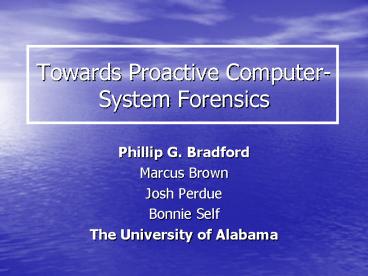Towards Proactive ComputerSystem Forensics - PowerPoint PPT Presentation
1 / 16
Title:
Towards Proactive ComputerSystem Forensics
Description:
(1) Use the Neyman-Pearson Lemma. Get best-critical regions for hypothesis testing ... Neyman-Person Lemma. Conditions to determine optimal critical regions ... – PowerPoint PPT presentation
Number of Views:83
Avg rating:3.0/5.0
Title: Towards Proactive ComputerSystem Forensics
1
Towards Proactive Computer-System Forensics
- Phillip G. Bradford
- Marcus Brown
- Josh Perdue
- Bonnie Self
- The University of Alabama
2
Outline
- Motivation
- Classical Forensics
- Digital Forensics
- Different from Classical Forensics
- Leverage Computer Science
- This papers focus
- Sequential Statistics
- System Design
- Conclusions
3
Motivation
- Computer Assisted Crimes
- Computer Enabled crimes
- Focus computer enabled crimes
- Employees or stakeholders of a firm
- Most likely to commit computer crimes against the
firm - Which employees should be the focus?
- Must be careful of resource use!
- A few Cycles to ensure security before donating
them!
4
Classical Digital Forensics
- Classical Forensics is reactive
- Digital Forensics has opportunity to be proactive
- Digital forensics (so far)
- A lot of focus on file recovery from disks
- Generally reactive
- Computer Security
- Focus on preventative measures
5
Proactive Computer-System Forensics
- System structuring and augmentation for
- Automated data discovery
- Lead formation
- Efficient data preservation
- Make these issues proactive
- Challenges
- System resources
- Exposure
6
Proactive Forensics
- Our proposal
- Sequential Hypothesis testing
- (1) Use the Neyman-Pearson Lemma
- Get best-critical regions for hypothesis testing
- Assuming empirical data
- (2) Use classical Stopping rules
- Aggregate cost is the same as fixed sample
hypothesis testing - Incremental cost is negligible
7
Proactive Forensics Principles
- Small-security-breach Principle
- A single breach of a system can be catastrophic.
- Viruses as small as 1K bytes
- Small-user-world Principle
- Most users only use a very few systems or
programs. - Incremental violation Principle
- Learning curve for breaking (internal) security
8
Implementing Proactive Forensics
- Fixed Hypothesis Testing
9
Implementing Proactive Forensics
- How often do we run fixed hypothesis testing?
- How much data do we save?
- How costly?
- How can we adjust it with the changing demands of
our employees?
10
Sequential Hypothesis Testing
- Let f(Xi, T1) or f(Xi, T2) be the ith data points
for samples from T1 and T2. - Likelihood ratio
- Rn S log ( f(Xi, T1) / f(Xi, T2) )
- For i?1 to n
- Stopping Rule
- Used to focus more resources
11
Sequential Hypothesis Testing
- Given a and b
- H0 holds with error probability a
- H1 holds with error probability b
- Let A ? (1- b)/a and B ? b/(1- a)
- Stopping Rule
- Stop if Log(B) gt Rn or Rn gt Log(A)
- If Rn lt Log(B), then H0 with conf. a
- If Rn gt Log(A), then H1 with conf. b
12
Stopping Rule
- A. Wald showed the stopping rule will eventually
terminate with probability 1. - Convergence issues
- Also
- Wald and Wolfowitz
- This is the best ratio test possible
- Expected number of steps to get conclusion is at
least as good as any other test
13
Back to Forensics
- Neyman-Person Lemma
- Conditions to determine optimal critical regions
- Best regions for determining which category the
data falls into - Why is optimality important?
- Forensics!!
14
Implementation Issues
- Starting work with FUPIDS
- Fuzzy User Profile Intrusion Detection
- By S. Wendzel
- Gathers data and compares to static tables of
expectations - Modified the kernel on openBSD
- Small mods, but potentially costly in timing
- Stays stealthy
15
Implementation Issues
- How we are different
- Data is not static
- Online rebalancing
- We use sequential statistics
- Focus more resources on target users
- Not just for intrusion detection
- Still potentially costly!
16
Conclusions
- Proactive Forensics
- New area
- Different from intrusion detection, security,
classical digital forensics - May be unique to computers networks
- Lots of possibilities































